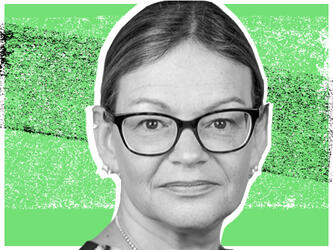Get the big picture
Josh: “You’re going to tell the President how the meeting he just had with his Council of Economic advisers related to the meeting he had with the Agriculture Secretary, relates to his intelligence briefing, relates to the environment, relates to jobs, relates to education, relates to the campaign. You’re his wide-angle lens.”
— The West Wing
That quote outlines the challenge facing organisations today. They do not require passive information. They want someone to contextualise it. This framing is how they make sense of their complex world.
We have moved beyond the Information Age into the Conceptual Age. We can access increasing amounts of data but, paradoxically, this can overload an organisation rather than liberate it. Today decision-makers want smart conceptualisations of data to help them understand ambiguity and cope with uncertainty.
They want conceptual frameworks that allow them to understand the robustness of data while, at the same time setting the evidence in the context of the familiar business world.
Our seven frame approach helps analysts join up all their evidence, understand the bigger conceptual picture and convey it as an engaging story.
The enemy of lucid conceptual storytelling is data silo thinking. It is never enough only to be clear about a tiny part of the research data. We must be fluent in looking across the evidence. To achieve this the analyst must have clear frameworks in place to ensure the key analytical processes have been addressed. Otherwise the analyst may panic and tackle the different data sets in a chaotic and confused way.
The power of framing is a lesson taught to us by Edward de Bono. In Six Thinking Hats wrote ‘Doing one thing at a time is simpler than trying to do many things and worrying that we might be leaving out something important.’ We can apply this logic to market research and the art of telling an evidence-based story.
By separating out the different frames, and ensuring we only look through one frame at a time, we guarantee that we cover all of the different ways of thinking about our evidence in a disciplined way to ensure we tell a comprehensive business story.
This article is not going to provide a single magic formula for integrating data. Instead we will look at framing different data inputs from various perspectives. This is the stepping stone to joining up our consumer insights into a compelling narrative. So we will now focus on the seven frames through which analysts must learn to filter their data in order to deliver an engaging storyline.
The scoping frame
Stephen Covey says, in his book The Seven Habits of Highly Effective People, that a key success habit is that when tackling any problem, you should always ‘start with the end in mind’. Thus the start point for the analyst when examining their data is the application of the scoping frame.
This means ensuring we understand the end expectations of the client. By definition, if the analyst was never working on the right problem it is unlikely he/she will generate the right solutions. Here the critical skill is the ability to stay focused on ensuring that you are answering the business objectives. If you fail to apply the scoping frame your best view of the business objectives will be through the bathroom window. You will only have a hazy outline, rather than a crisp image.
The evaluation frame
The bedrock of any attempt to integrate different types of research evidence will be the traditional techniques we have for evaluating the robustness of evidence. In applying the evaluation frame we would expect the analyst to know what is in the technical toolbag for assessing statistical significance and so on. But this frame goes beyond this to include the wisdom and nous needed to assess, not only statistical significance, but the importance of data.
Here we should not take for granted the fact that analysts are au fait with what is in the toolbag. For example, it is not good enough to defend qualitative research by repeating some limp ‘trust me’ mantra. We live in the Conceptual Age, so we must now reach for the appropriate concepts – such as Grounded Theory – that allow us to explain to senior decision-makers, in an authoritative way, the theoretical underpinning of the qualitative method. So the application of our evaluation frame requires a comprehensive understanding of how analysts go about assessing the robustness of different types of supporting evidence.
The experience frame
The ability to apply the evaluation frame is a necessary but not sufficient condition of the integrated analysis of data. This brings us to the third frame to apply: the experience frame.
The classic evaluation techniques discussed above only take us so far. We must dip into the body of best practice and practical experience that the research industry has built up about what works and does not work when using different types of methodology.
Thus we need to pass our data through the knowledge filters. These are questions and techniques that can be applied to our data to help us decide whether and, by how much, it is legitimate to compensate for any shortfalls in the quality of our data, given the realities of applying the coarse art of survey research. In this way, factors that we know will hinder even the most professionally conducted surveys will be compensated for so that we do not come up with an overly theoretical or naive interpretation.
Here we are referring to compensating for what we know about respondents’ tendency to: post-rationalise responses, provide generalised platitudes rather than true attitudes, and also overcome issues such as poor memory recall. In short the experience frame means that all of our knowledge is applied to offset some of the limitations of the survey method, and ensure that we deliver a robust understanding of what respondents are trying to tell us.
From this now technical, then experienced and seasoned, evaluation of our data we must now begin to assimilate the different strands of our research into a single evidence-based story. This takes us to our next frame.
The holistic frame
The holistic frame is the process through which an analyst can begin to understand what the combination of desk, qualitative, quantitative and management information means for the resolution of the issue under investigation.
In applying the holistic frame we must leave behind traditional ways of analysing data and pursue more conceptual ways of looking at combinations of data sets. One way forward is to look at the weight, power and direction of each data set and then use these concepts as the lynchpin around which to construct an integrated story.
‘Weight’ tells us about the numerical support for an idea, in relation to the depth of feeling about it. ‘Power’ tells us about the relationship between the known robustness of our methodology, in the context of what we already know about this topic from knowledge filters. And ‘Direction’ tells us about within data set and across data set consistency. From here we can develop a fuzzy logic evaluation of what the combined data sets are telling us.
The enrichment frame
So far we have focused on the actual data we have collected from our research. However there is only so much that respondents can tell us, so increasingly the analyst – given their experience and own insights – is being asked to stretch the data. This reflects the fact that today analysts can be seen as admissible evidence. Thus our enrichment frame reminds us of, and legitimises, the role the analyst now plays in stretching the literal survey evidence, using a range of creative enablers that are in the research toolbag.
For example, we can take the literal survey data and apply what we know from semiotics – the art of taking the outside-in perspective to counter more limited inside-out thinking – to add colour and context to the research picture. Similarly, we use techniques such as synectics, which encourages us to play with metaphor and analogy in order to identify the larger concepts that sit over and above much of our tactical data, and really tell us what is going on. So increasingly in ‘activation workshops’, you will find analysts applying the enrichment frame to help frame – in fact reframe – the original data.
The business frame
Decision-makers make sense of complexity by locating the vast amounts of data with which they have to cope each day in the context of familiar business frameworks. Specifically, these frameworks allow them to apply the business heuristics they have built up over time. These heuristics inform them about what will and won’t work, in different set piece business scenarios. In short the business frame is critical to integrating survey data, as these frameworks provide a shorthand way for decision-makers to quickly make sense of complexity.
It is helpful to think of the application of the business frame as an iterative process of looking at the consumer data, then setting it in the business context of what else we know about the problem. It is a double-sided process of fitting data into a frame, then fitting a frame around the data. Importantly, neither frame nor data comes first. Data evokes frames, and frames select and connect data. So when there is not a fit, the data or frame must be revisited.
The business frame, by locating evidence in frameworks that are immediately accessible to decision-makers, also helps us win the attention of the boardroom-level audience in embedding research data into powerful frameworks that touch their world.
The decision frame
The decision frame takes market research beyond just throwing our research data over the wall as a series of consumer insights. Decision-framing means fashioning a clear cut set of choices that flow from these insights.
Lou Gerstner, the ex-chairman of IBM, said: ‘Once someone has framed the choices making the decision is easy’. So the final decision frame focuses on techniques that allow the analyst to crystallise the evidence into clear choices for the decision-maker. It is also about knowing about the pitfalls that can bedevil evidence-based decision-making, and guiding the decision-maker through the minefield to the successful activation of their decisions.
Putting the seven frames on the skills development agenda
We have tried to highlight the importance to the market research industry of becoming the client’s wide-angled lens. Our thesis is that data integration is about the
art of framing individual pieces of evidence from different angles as the segue into telling the consumer story. Seven frames provide the answer to the challenge of integrating data, rather than the hope that we will come up with a simple technical fix that will automatically provide the magic formula for integrating our eclectic range
of data.
Of course advances in individual techniques, such as the fusion of survey data with customer records, will continue to be invaluable to us. But these technical advancements only take us so far in the quest to give analysts the skillset needed to think holistically and construct and tell powerful stories that will stick with decision-makers and make a difference.
Our view is that analysts who want to go beyond being mere purveyors of data must learn to become providers of a wide-angle lens, framing the way forward for clients.

We hope you enjoyed this article.
Research Live is published by MRS.
The Market Research Society (MRS) exists to promote and protect the research sector, showcasing how research delivers impact for businesses and government.
Members of MRS enjoy many benefits including tailoured policy guidance, discounts on training and conferences, and access to member-only content.
For example, there's an archive of winning case studies from over a decade of MRS Awards.
Find out more about the benefits of joining MRS here.










0 Comments